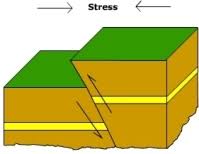What are the causes of Earthquakes?
A) When rocks are joint together
B) When rocks break along a fault, vibrations are created.
C) when rocks unite to create more rocks
B) When rocks break along a fault, vibrations are created
What are Seismic waves?
waves generated by earthquakes
___________________ move through Earth by causing particles in rocks to move at right angles to the direction of the waves.
Secondary waves
P- waves=
S- waves=
Primary waves
Secondary waves
What are the three types of faults?
A) normal, conditionally, diverse
B) normal,reverse, converse
C) normal, reverse, strike-slip fault
B) normal,reverse, converse
which of the following are types of Seismic waves?
A) P-wave
B) S-wave
C) L-wave
D) R-wave
E) All of the above
E) all of the above
To locate an earthquake's _____________, scientists use information from three seismograph stations.
epicenter
why do we study about Seismic waves?
to know and prepare for an earthquake
they travels through the layers of the earth
How are faults formed?
A) by forces that compress or stretch a section of Earth's crust.
B) by compression in the air that reaches to the inner core
A) by forces that compress or stretch a section of Earth's crust.
which of the following are body waves?
A) primary and secondary waves
B) Love and Rayleigh waves
A) Primary and Secondary waves
True/ False
The lowest seismic waves are surface waves
true
who came up with the theory of continental drift?
Alfred W.
True/ False
In a strike-slip fault, two blocks of rock slide horizontally past each other.
True
The______________ waves are the first to reach the seismograph after an earthquake.
A) Surface
B) Secondary
C) Primary
D) Tsunami
C) primary
_____________ waves arrive at the Seismograph stations.
primary
What is Pangea?
former super Continent on Earth.
The pciture shows a normal fault, where forces push two blocks of rock together

False.
The image shows a reverse fault when forces push rocks together
Looking at the figure that shows world-wide earthquakes distribution, the white lines represent plate boundaries. which statement is true?
A) Earthquakes always occur along plate boundaries
B) Earthquakes most frequently occur along plate boundaries
C) Earthquakes rarely occur along plate boundaries
D) Earthquakes never occur along plate boundaries
B) Earthquakes most frequently occur along plate boundaries
Match the following features of an earthquake to the correct label on the figure
A)
B)
A) Epicenter
B) Focus
What is the connection between Plate tectonics and Earthquakes
The tectonic plates move towards, away or past each other at plate boundaries. This movement will concentrate a lot of energy as rocks are deformed. When rocks break, they will release an incredible amount of energy and will shake the ground, what we call earthquakes. Most of the earthquakes in the Earth occur at plate boundaries due to the ongoing movement of the plates. If we know where the plate boundaries are, then we also know where most of the earthquakes occur.